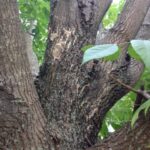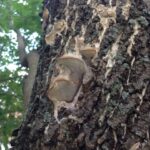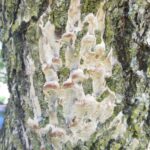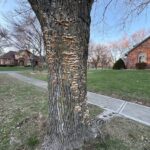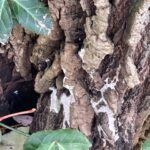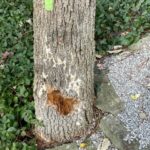By now, the emerald ash borer (EAB) invasion is an old story for landscapes and forests in the Midwest. Since EAB was first found in North America in 2002 more millions of ash trees than we can know have died and this tiny insect continues to kill ash in an ever widening zone that currently includes 37 US states and 6 Canadian provinces. Arborists and landscape managers continue to protect valuable ash trees by use of systemic insecticides, typically applied via trunk injection every 2-3 years.
While EAB is the overarching threat, ash survival may also be threatened by wood decay fungi, which may colonize insect exit holes, injections sites and other wounds. The most common decay fungi we see in the lab are Perenniporia and Fomitopsis.
Perenniporia fraxinophila is the most frequently reported wood decay fungus on ash and causes a heart rot that contributes to loss of structural integrity of the tree. Infection sites tend to be high on the tree and may be easily overlooked until decay is advanced. The fungal structure is perennial, expanding each year, and may be confused with Ganoderma applanatum, the artist’s conk. The upper surface turns black or brown with age and the underside is white with pores instead of gills.
- Figure 1: Upper ash branches colonized by a suspected Perenniporia sp.
- Figure 2: Fungal conks of a suspected Perenniporia sp., beginning to emerge from decaying ash branches.
- Figure 3: Fungal conks of a suspected Perenniporia sp., beginning to emerge from decaying ash branches.
In the last few years, we have had a few samples of a similar fungus colonizing the trunk and base of ash trees, often near injection sites. Initially we were unable to identify the fungus, but DNA analysis revealed the fungus was a Fomitopsis species. This fungus develops a shallow shelf structure with white top and tan underside.
Fungal decay presents a greater risk to ash because it lacks the preservative enriched heartwood found in oak, walnut and other hardwoods that tends to slow down internal spread of fungi. Even fungi that initially invade dead areas of ash may rapidly colonize and degrade stem and trunk tissue.
- Figure 4: Fomitopsis sp. colonizing the trunk of ash trees damaged by EAB.
- Figure 5: Figure 4: Fomitopsis sp. colonizing the trunk of ash trees damaged by EAB.
- Figure 6: Figure 5: Figure 4: Fomitopsis sp. colonizing the trunk of ash trees damaged by EAB.
Fungal decay also disrupts vascular tissues in the stems and trunk, which further limits the movement and effectiveness of insecticide injections, so that infected trees may face greater damage from EAB. When found on small side branches the infection might be successfully pruned out, but in most cases the decay is in major branches or the trunk, which means the tree will need to be removed. If your ash trees that are being regularly treated for EAB but continue to show thinning and decline, check for these fungal invaders, they may be partly responsible.
References:
EAB Network: https://www.emeraldashborer.info/about-eab
Incidence of Perenniporia fraxinophila and its effects on green ash (Fraxinus pennsylvanica) woodlands in eastern Montana, USA: https://www.sciencedirect.com/science/article/pii/S0378112703000112
Perenniporia fraxinophila: https://www.mushroomexpert.com/perenniporia_fraxinophila.html
Diseases of Trees and Shrubs, 2nd Ed. Wayne Sinclair and Howard Lyon, Cornell University Press.
